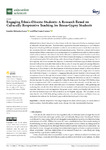Mostrar o rexistro simple do ítem
Engaging Ethnic-Diverse Students: A Research Based on Culturally Responsive Teaching for Roma-Gypsy Students
| dc.contributor.author | Meléndez-Luces, Jennifer | |
| dc.contributor.author | Couto-Cantero, Pilar | |
| dc.date.accessioned | 2022-01-10T11:24:42Z | |
| dc.date.available | 2022-01-10T11:24:42Z | |
| dc.date.issued | 2021 | |
| dc.identifier.citation | Meléndez-Luces, J.; Couto-Cantero, P. Engaging Ethnic-Diverse Students: A Research Based on Culturally Responsive Teaching for Roma-Gypsy Students. Educ. Sci. 2021, 11, 739. https://doi.org/10.3390/educsci11110739 | es_ES |
| dc.identifier.uri | http://hdl.handle.net/2183/29322 | |
| dc.description.abstract | [Abstract] Intercultural Education is a key feature in the development of inclusion strategies aimed at ethnically diverse students. Transformative approaches towards learning such as Culturally Responsive Teaching (CRT) are essential in order to answer the educative needs that arise due to the coexistence between ethnic minorities and mainstream society. Therefore, cultural and historical representation of these communities play an important role as gatekeepers in order to achieve positive results as far as inclusive education is concerned. This article explores research based on a case study carried out in a high school located in the North-West of Spain developing successful learning stories after implementing the CRT methodology within the teaching of English as a foreign language. For its development, this article examines the trajectory of education with Roma-Gypsy students and moves forward with previous studies that endorse the success of using this approach among ethnically diverse students for their inclusion within the educative system. Intercultural and Plurilingual Education is a key feature in the development of inclusion strategies aimed at ethnically diverse students. This article includes research based on a case study carried out in a high school located in the North-West of Spain. It is aimed at: 1. Engaging ethnically diverse students to become part of the mainstream classroom through the inclusion of their culture; 2. Improving their language skills and competencies in the learning of a foreign language; 3. Raising the attendance at schools of ethnically diverse students. To achieve these targets the Culturally Responsive Teaching (CRT) Methodology has been implemented. CRT is considered essential to answer the educative needs that arise due to the coexistence between ethnic minorities and conventional communities. After gathering and analyzing data, results show that: ethnically diverse students’ motivation has been increased; it also expanded their social skills among peers; they gained more visibility; and finally, both diverse and non-diverse learners improved their proficiency in the English language. The discussion section states that the use of CRT Methodology traditionally used with Afro-American and Native-American students is also relevant for the Roma-Gypsy students that took part in this study. | es_ES |
| dc.language.iso | eng | es_ES |
| dc.relation.uri | https://doi.org/10.3390/educsci11110739 | es_ES |
| dc.rights | Atribución 4.0 Internacional | es_ES |
| dc.rights.uri | http://creativecommons.org/licenses/by/4.0/ | * |
| dc.subject | Culturally Responsive Teaching | es_ES |
| dc.subject | Bilingual education | es_ES |
| dc.subject | Roma-Gypsy | es_ES |
| dc.subject | Inclusion | es_ES |
| dc.subject | Intercultural education | es_ES |
| dc.subject | Pluriculturalism | es_ES |
| dc.subject | Equity | es_ES |
| dc.subject | Social change | es_ES |
| dc.subject | Diversity | es_ES |
| dc.subject | Transformative learning | es_ES |
| dc.title | Engaging Ethnic-Diverse Students: A Research Based on Culturally Responsive Teaching for Roma-Gypsy Students | es_ES |
| dc.type | info:eu-repo/semantics/article | es_ES |
| dc.rights.access | info:eu-repo/semantics/openAccess | es_ES |
| UDC.journalTitle | Education Sciences | es_ES |
| UDC.volume | 11 | es_ES |
| UDC.issue | 11 | es_ES |
| UDC.startPage | 739 | es_ES |
| dc.identifier.doi | 10.3390/educsci11110739 |
Ficheiros no ítem
Este ítem aparece na(s) seguinte(s) colección(s)
-
GI-DILEC - Artigos [20]






